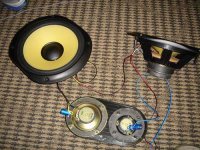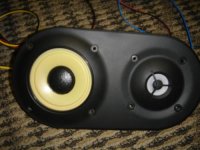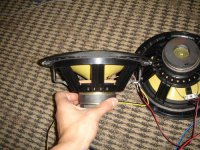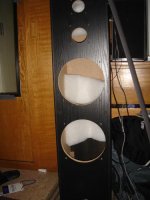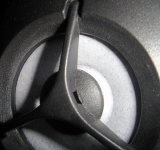Hey everyone, this is my first post to the forum.
The diagrams I talk about in this post are enclosed in the zip file
Speaker Diagrams.zip (sorry about the bad quality but i had to compress the hell out of them to get thme to fit)
I am posting concerning a pair of Sony SS-MF750H Floor standing speakers I own. I was recently comparing my speakers to a pair of my roommates Polk bookshelf speakers. Upon listening I noticed everything wrong about my speakers, mainly the mids and highs of the speakers did not sound good at all. I became interested in what types of crossovers were used in my speakers and this is what I found (see picture one).
After analyzing the values for the capacitors and the resistance for each of the drivers I became confused. The 4 drivers in the speaker unit are all wired in parallel. The two 8 inch drivers have a resistance of 15.2 ohms the midrange has a resistance of 7.8 ohms and the tweeter has a resistance of 4.7 ohms. Using the formula (1/((1/R1)+(1/R2)+…+(1/Rn))) to calculate the total resistance I obtained a value of around 2 ohms which doesn’t make sense because measuring the terminals at the back of the speaker I got a value of 7.8 ohms.
However there was another feature that really confused me about these speakers, which was the value for the capacitors on the tweeter and midrange. The midrange had a 2.7uf cap and the tweeter had a 1.3uf cap. To calculate the crossover frequencies I used the equation C=(0.159/R*F) where C is the capacitance (in farads) R is the resistance (in ohms) and F is the crossover frequency (in Hz). I solved for F=(0.159/C*R). (for the R I wasn’t sure weather to use the resistance of the driver, or the resistance of the entire speaker so I tried both and I will list both: driver then entire speaker) for the crossover frequency of the tweeter I obtained 28.2 kHz or 17kHz (depending on if I used the 4.7 ohms for the driver or the 7.8 for the entire speaker) for the midrange I obtained a value of 7.5 kHz. My problem with these values is that they seem to be way to high to be the proper crossover points for my speakers.
I wasn’t convinced so I tested the response of each driver using true RTA and a microphone I had around. I set each driver on the floor so that they would fire upwards and suspended the microphone about 6 inches from the driver. I turned my amplifier to a mid volume and connected the speaker wires directly to the terminals of the speaker, so that I would bypass any sort of capacitor. I used TrueRTA and performed a quick sweep where it sweeps all the frequencies and records the peak value for each 1/24 octave. I took screen shots of the graph for each driver, and I’m including them here. Because I live in a dorm it is not always the quietest environment. I’m not saying that these graphs are anywhere close to being absolutely accurate; however I do think they are able to tell you something about the speakers.
After looking at the graphs I concluded that proper crossover frequencies should be around 1400 Hz for the low to mid cutoff point and 4800 Hz for the mid to high cut off point.
I guess my whole point in writing this message would be to ask if anyone could give me any insightful information of whether It would be wise to attempt to build a new crossover for these speakers based on the information and resources I have (I cant find any information about the parameters for the drivers from Sony) Or if it would just be better to upgrade the capacitors to better ones (I’m pretty sure the ones being used now are cheap electrolytic ones) or would It be best just to leave them alone. (buying new speakers is not an option right now)
Thanks to anyone who can point me in the right direction!
Charlie
The diagrams I talk about in this post are enclosed in the zip file
Speaker Diagrams.zip (sorry about the bad quality but i had to compress the hell out of them to get thme to fit)
I am posting concerning a pair of Sony SS-MF750H Floor standing speakers I own. I was recently comparing my speakers to a pair of my roommates Polk bookshelf speakers. Upon listening I noticed everything wrong about my speakers, mainly the mids and highs of the speakers did not sound good at all. I became interested in what types of crossovers were used in my speakers and this is what I found (see picture one).
After analyzing the values for the capacitors and the resistance for each of the drivers I became confused. The 4 drivers in the speaker unit are all wired in parallel. The two 8 inch drivers have a resistance of 15.2 ohms the midrange has a resistance of 7.8 ohms and the tweeter has a resistance of 4.7 ohms. Using the formula (1/((1/R1)+(1/R2)+…+(1/Rn))) to calculate the total resistance I obtained a value of around 2 ohms which doesn’t make sense because measuring the terminals at the back of the speaker I got a value of 7.8 ohms.
However there was another feature that really confused me about these speakers, which was the value for the capacitors on the tweeter and midrange. The midrange had a 2.7uf cap and the tweeter had a 1.3uf cap. To calculate the crossover frequencies I used the equation C=(0.159/R*F) where C is the capacitance (in farads) R is the resistance (in ohms) and F is the crossover frequency (in Hz). I solved for F=(0.159/C*R). (for the R I wasn’t sure weather to use the resistance of the driver, or the resistance of the entire speaker so I tried both and I will list both: driver then entire speaker) for the crossover frequency of the tweeter I obtained 28.2 kHz or 17kHz (depending on if I used the 4.7 ohms for the driver or the 7.8 for the entire speaker) for the midrange I obtained a value of 7.5 kHz. My problem with these values is that they seem to be way to high to be the proper crossover points for my speakers.
I wasn’t convinced so I tested the response of each driver using true RTA and a microphone I had around. I set each driver on the floor so that they would fire upwards and suspended the microphone about 6 inches from the driver. I turned my amplifier to a mid volume and connected the speaker wires directly to the terminals of the speaker, so that I would bypass any sort of capacitor. I used TrueRTA and performed a quick sweep where it sweeps all the frequencies and records the peak value for each 1/24 octave. I took screen shots of the graph for each driver, and I’m including them here. Because I live in a dorm it is not always the quietest environment. I’m not saying that these graphs are anywhere close to being absolutely accurate; however I do think they are able to tell you something about the speakers.
After looking at the graphs I concluded that proper crossover frequencies should be around 1400 Hz for the low to mid cutoff point and 4800 Hz for the mid to high cut off point.
I guess my whole point in writing this message would be to ask if anyone could give me any insightful information of whether It would be wise to attempt to build a new crossover for these speakers based on the information and resources I have (I cant find any information about the parameters for the drivers from Sony) Or if it would just be better to upgrade the capacitors to better ones (I’m pretty sure the ones being used now are cheap electrolytic ones) or would It be best just to leave them alone. (buying new speakers is not an option right now)
Thanks to anyone who can point me in the right direction!
Charlie
Attachments
You have to consider the XO when calculating the total impedance. Because of the caps the mid & tweeter will have very high impedance below their cutoff.
I'd like to see pictures of the drivers.
This looks to be a speaker designed by the marketing/accounting department. The mid XO point is choosen because that is where the midwoofers roll off. The tweeter is just tacked on so they can call it a 3-way.
On 1st blush (i'd like to see a pic (& impedance curves)) of the drivers, i'd say toss the midrange completely and make it a 2.5-way system.
You might be better off starting from scratch thou -- i bet an FE127e or FR125s would be quite a bit better. I suspect the boxes aren't anything hot either.
dave
I'd like to see pictures of the drivers.
This looks to be a speaker designed by the marketing/accounting department. The mid XO point is choosen because that is where the midwoofers roll off. The tweeter is just tacked on so they can call it a 3-way.
On 1st blush (i'd like to see a pic (& impedance curves)) of the drivers, i'd say toss the midrange completely and make it a 2.5-way system.
You might be better off starting from scratch thou -- i bet an FE127e or FR125s would be quite a bit better. I suspect the boxes aren't anything hot either.
dave
I honestly think you'll be wasting your time building new crossovers for these speakers - the improvement would be marginal at best. You're better off replacing the drivers AND the crossover, and yes ditch the mid & go for a 2-way.
The drivers Sony uses for most of its speakers IMHO are in the "junk" category - very high distortion etc. I recently rebuilt a similar pair for my roommate, basically gutting the whole things except for the cabinets, which got rib bracing, damping panels, foam panels & polyfill, then Peerless & SEAS drivers, and a 12 db crossover at 3000 hz.
The difference is night and day, especially given the non-ideal box alignment and non-optimized crossover. There wasn't even a real crossover in the original - just a single cap on everything, and the drivers were just basement stuff.
If you don't want to build from scratch but just use the cabs as a starting point this would be the recommended way to go.
The drivers Sony uses for most of its speakers IMHO are in the "junk" category - very high distortion etc. I recently rebuilt a similar pair for my roommate, basically gutting the whole things except for the cabinets, which got rib bracing, damping panels, foam panels & polyfill, then Peerless & SEAS drivers, and a 12 db crossover at 3000 hz.
The difference is night and day, especially given the non-ideal box alignment and non-optimized crossover. There wasn't even a real crossover in the original - just a single cap on everything, and the drivers were just basement stuff.
If you don't want to build from scratch but just use the cabs as a starting point this would be the recommended way to go.
Thanks for the advice to everyone who posted! However scraping the speakers and buying new ones, or even buying new drives is out of the question for me at the moment. With school eating up most of my money and free time it’ll be a few years before I can afford/design a nice pair of speakers.
I was mainly asking the question to see if there was anything I could do that might increase the quality of the speakers a little but without costing me a whole lot. I’m not looking for superb quality audio. But, maybe just a little better than what I have now. A friend of mine recommended upgrading the capacitors in the cabinets to some higher quality ones. I’m considering doing it if it will make a difference since it will only cost me about $20.
Next time I take my speakers apart I’ll take some pictures of the drivers and post them. But for now I need to finish my school work. Maybe tomorrow.
P.S. can anyone tell me how to post multiple pictures?
Thanks again
Charlie
I was mainly asking the question to see if there was anything I could do that might increase the quality of the speakers a little but without costing me a whole lot. I’m not looking for superb quality audio. But, maybe just a little better than what I have now. A friend of mine recommended upgrading the capacitors in the cabinets to some higher quality ones. I’m considering doing it if it will make a difference since it will only cost me about $20.
Next time I take my speakers apart I’ll take some pictures of the drivers and post them. But for now I need to finish my school work. Maybe tomorrow.
P.S. can anyone tell me how to post multiple pictures?
Thanks again
Charlie
Originally posted by newcharliepuch I’m considering doing it if it will make a difference since it will only cost me about $20.
puzzlecoat (paper cones?), ductseal, better wire, brace the box. try disconnecting the midrange and hook the tweeter up to the midrange cap. That's less than $20 and done well can transform a speaker
P.S. can anyone tell me how to post multiple pictures?
either multiple posts or put the pictures up in web space & link to them.
dave
How big is that "midrange"? And they have put a good disguise on the cone tweeter to make you think it is a dome. Note the cover over the dustcap. With the small cap on it and the disguise it probably contributes nothing.
What is the cone material on the midwoofs?
Better caps wouldn't hurt either.
dave
What is the cone material on the midwoofs?
Better caps wouldn't hurt either.
dave
here is the description of the drivers from the sony site
Dual 8" Improved H.O.P. Cone - Bass Driver
(Highly Oriented Polyolefin/Kevlar blend)
3 1/4" Improved H.O.P. Cone - Mid Driver
1" Nano-Fine® Balanced Dome Tweeter
here is a close up of the tweeter too
Dual 8" Improved H.O.P. Cone - Bass Driver
(Highly Oriented Polyolefin/Kevlar blend)
3 1/4" Improved H.O.P. Cone - Mid Driver
1" Nano-Fine® Balanced Dome Tweeter
here is a close up of the tweeter too
Attachments
Maybe a fullrange driver can better be used to swap with the mid and tweet section..(one to fit the midrange hole, put a tube behind the fullrange (cardboard or pvc tube preferrably dampened with bitumen and padding) to seal it off from the woofer-enclosure).
Maybe you can afford a pair of veravox 3 or some fostex drivers....
Things would improve a lot with a t-amp ("sonic impact"produces one for only 19 dollars that sounds quite brilliant*...).
You can use your present amplifier on the woofers and the t-amp on the fullranges.
http://www.tnt-audio.com/ampli/t-amp_e.html
I can give you a schematic on how to filter things in a very affordable way (with bi-amping you can use "pllxo" filtering on the inputs with just four small components on the inputs!).
The woofers look pretty good to me by the way, just use some extra padding in the cabinets and I'm pretty sure that your's can beat the polk-audio speakers....
*but some are sadly not so reliable.....
Maybe you can afford a pair of veravox 3 or some fostex drivers....
Things would improve a lot with a t-amp ("sonic impact"produces one for only 19 dollars that sounds quite brilliant*...).
You can use your present amplifier on the woofers and the t-amp on the fullranges.
http://www.tnt-audio.com/ampli/t-amp_e.html
I can give you a schematic on how to filter things in a very affordable way (with bi-amping you can use "pllxo" filtering on the inputs with just four small components on the inputs!).
The woofers look pretty good to me by the way, just use some extra padding in the cabinets and I'm pretty sure that your's can beat the polk-audio speakers....
*but some are sadly not so reliable.....
How are things with the SS-MF750H's? I've got a pair myself and I got fed up with the mid's and highs and disabled them all together. I've put a pair of Audio Nirvana Super 6.5's with Pioneer AHE60-51F Horn Tweeters in their place, but in their own cabinents. I would like to tweak the Sony's though so I can use them on their own.
I may try attaching my Pioneer AHE60-51F Horn Tweeters to see what happens. I'm guessing a 6uF cap for an 8ohm driver should do the trick? That or changing the Mid's filter cap for something like a 20uF.
From looking the cap values I'd estimate the Mid is comming in around 8000 Hz or higher? More like a tweeter than a mid if you ask me. The tweeter is probably more of a cosmetic piece in this arrangement.
I would like to salvage the woofers. True they're cheap, but their also paid for. I don't really crank it up anyway, having only about 30w RMS of steam. Anyone suggest a crossover config and tweeter?
I may try attaching my Pioneer AHE60-51F Horn Tweeters to see what happens. I'm guessing a 6uF cap for an 8ohm driver should do the trick? That or changing the Mid's filter cap for something like a 20uF.
From looking the cap values I'd estimate the Mid is comming in around 8000 Hz or higher? More like a tweeter than a mid if you ask me. The tweeter is probably more of a cosmetic piece in this arrangement.

I would like to salvage the woofers. True they're cheap, but their also paid for. I don't really crank it up anyway, having only about 30w RMS of steam. Anyone suggest a crossover config and tweeter?
You can't just take the average impedance to know the crossover frequency for a certain filter-driver combo. That's why you should measure, or at least know the impedance of the driver where you desire it to cross over. (since impedance varies a lot over frequency with most drivers, you need an impedance curve to be able to estimate with certain precision...). Don't know if you want to keep the original filter, I would probably not.....so maybe there isn't even much of a point in knowing what it does, especially if you won't use the mid/high range drivers anyway....
Nevertheless I think you're right about the high x-over freq. of the mid, and the tweeter being more of a cosmetic piece here...😀
What exactly do you not like about the mids by the way?
I think a Monacor SPH-30X would also be a very good match, I made a lot of progress with PLLXO notch filters to make it sound quite hifi (actually lacking just a bit of bass in the lowest regions, which the woofer of the MF750's could fix...) It has very nice and detailed highs in my configuration, high efficiency and reasonably good power handling... But most important, it just sounds nice...
But if you don't care about possibly blowing up the midrange in the sony you can try to cross it lower. Maybe you can connect it without filter and listen to what it is capable of (carefully though!) and if you think it can go lower than with the original filter you increase the cap value a bit. And if you still miss some highs you add a tweeter, though I'm not so sure whether the horn tweeter would match that well....not so nice to have to add a lot of L-pad if you know what I mean...
Nevertheless I think you're right about the high x-over freq. of the mid, and the tweeter being more of a cosmetic piece here...😀
What exactly do you not like about the mids by the way?
I think a Monacor SPH-30X would also be a very good match, I made a lot of progress with PLLXO notch filters to make it sound quite hifi (actually lacking just a bit of bass in the lowest regions, which the woofer of the MF750's could fix...) It has very nice and detailed highs in my configuration, high efficiency and reasonably good power handling... But most important, it just sounds nice...
But if you don't care about possibly blowing up the midrange in the sony you can try to cross it lower. Maybe you can connect it without filter and listen to what it is capable of (carefully though!) and if you think it can go lower than with the original filter you increase the cap value a bit. And if you still miss some highs you add a tweeter, though I'm not so sure whether the horn tweeter would match that well....not so nice to have to add a lot of L-pad if you know what I mean...
I removed the filter cap from the midrange and moved it to the tweeter. That was a 2.7uf cap. I measured 4.5 ohms. Hmmmm. I'll have to check the wiring. What a mish-mash of resistances!
I'll be driving only 18 watts for now so I don't think that will damage the midrange at modest volume levels. I'll be slapping on a 10uF to the midrange later.
I hope to add on at least a better tweeter for a two way design at some point. That and a better crossover. Gotta sell some stuff first.
Offtopic: I'd like to know more about notch filters for my Audio Nirvana Super 6.5's. The midrange is much too powerful for most listening. Nice drivers though
I'll be driving only 18 watts for now so I don't think that will damage the midrange at modest volume levels. I'll be slapping on a 10uF to the midrange later.
I hope to add on at least a better tweeter for a two way design at some point. That and a better crossover. Gotta sell some stuff first.
Offtopic: I'd like to know more about notch filters for my Audio Nirvana Super 6.5's. The midrange is much too powerful for most listening. Nice drivers though
I suppose the woofers can go up to pretty high frequencies, but I think a 2.5 way would be a better idea (one woofer producing bass and mid, the other mainly bass...) with a better tweeter...
Offtopic: http://www.audioasylum.com/forums/hug/messages/120394.html
Offtopic: http://www.audioasylum.com/forums/hug/messages/120394.html
I modified one speaker so I could compare. The 2.7uF 200V cap is on the tweeter now and I put my own 10uF 100V cap on the midrange. Compared to the unmodified speaker the midrange is just right now. The original speaker config sounds muffled in comparison.
I just can't put as much power into the speakers now with a 100V cap on there. 🙂
Folks should consider doing the same but with a 10uf 200V cap instead! Highly recommended. And a cheap solution.
I just can't put as much power into the speakers now with a 100V cap on there. 🙂
Folks should consider doing the same but with a 10uf 200V cap instead! Highly recommended. And a cheap solution.
- Status
- Not open for further replies.
- Home
- Loudspeakers
- Multi-Way
- DIY Speaker Upgrade Help
